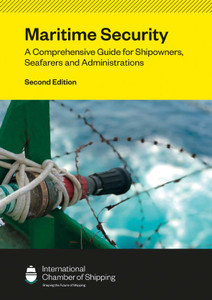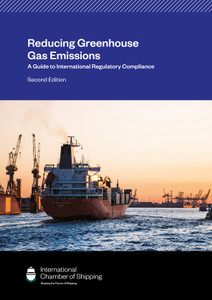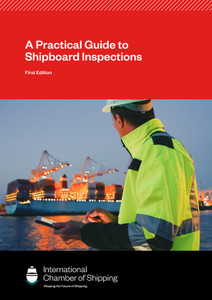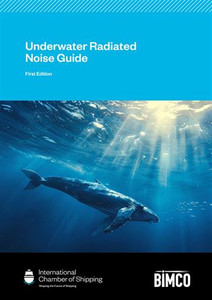
The new and improved edition of ICS Guide to Helicopter/Ship Operations has been reorganised to make it more user-friendly for crew to find relevant information quickly, and adds new ready-to-use content including:
- An enhanced shipboard safety checklist for helicopter operations, with tasks presented in chronological order
- a new risk assessment for landing and winching
- an aide memoire for the responsible officer
- an example toolbox talk before a helicopter operation
- further clarifications on roles and responsibilities
- updated terminology.
This guide can be used by ships' masters, officers and crew, and is also useful reading for helicopter operators and marine pilots. The sixth edition can also now be used alongside the e-learning course Helicopter Operation Procedures for Ships, available from the ICS Academy, giving crew access to on board procedures and training that work together seamlessly.
The new and improved edition of ICS 'Guide to Helicopter/Ship Operations' provides up-to-date and practical guidance for shipping companies and crew based on the latest feedback from maritime and aviation experts. For almost 50 years the guide has served as industry standard best practice and is a carriage requirement by some flag states. For today's technologically advanced and ever-growing shipping fleet, the goal remains the same: a safe and efficient operation for all involved.
The sixth edition has been reorganised to make it more user-friendly for crew to find relevant information quickly, and adds new ready-to-use content including:
- An enhanced shipboard safety checklist for helicopter operations, with tasks presented in chronological order
- a new, industry standard risk assessment for landing and winching
- an aide memoire for the responsible officer
- an example toolbox talk before a helicopter operation
- further clarifications on roles and responsibilities
- updated terminology.
The 'Guide to Helicopter/Ship Operations' can be used by ships' masters, officers and crew, and is also useful reading for helicopter operators and marine pilots. This guide will help shoreside teams develop shipboard operating procedures and requirements for the full range of helicopter operations that may be undertaken on board.
The 'Guide to Helicopter/Ship Operations' is an essential publication to have on board and its recommendations are reinforced by the new e-learning course, 'Helicopter Operation Procedures for Ships', available from the ICS Academy. Shipowners can use this course alongside the publication to assess crew's knowledge and competence on safe helicopter operations.
1.1 Introduction
The purpose of this Guide is to advise shipping companies, ships' crew, helicopter operators and helicopter pilots on the safe performance of helicopter/ship operations. Because of their different backgrounds, qualifications and experience, mariners and aviators are often unfamiliar with even the most basic technical aspects of each other's profession. This lack of mutual understanding can be dangerous, and this Guide attempts to remedy it.
This Guide provides advice on best practice from many aviation and maritime sources. Best practice is a constantly evolving process, and it should be noted that the Guide reflects best practice at the time of publication. There may be alternative means of ensuring safe operations and these need to be considered on their merits.
Appropriate procedures for helicopter operations should be incorporated within the company's Safety Management System (SMS) and any arrangements used, whether in line with these guidelines or elsewhere, should be subject to a risk assessment. There are three main categories of helicopter/ship operations:
1. Operations involving a contract between a shipping company and a helicopter operator. This category is the main focus of this Guide.
2. Operations involving a contract between some local organisation, e.g. a pilotage authority, and a helicopter operator. This Guide is also suitable for these applications, and section 5.3: Marine pilot transfer deals specifically with the transfer of marine pilots.
3. Operations for emergencies and/or rescue. Although this Guide primarily focuses on planned operations, many sections provide helpful information which is relevant to the use of helicopters in emergencies. In particular, time taken to establish an appropriate landing or winching area for use in an emergency could save time and reduce unnecessary risks if these operations are ever required.
As well as identifying designated roles, the company SMS should include the requirements for on board training and drills together with required manuals, procedures and checklists for use in normal operations and in an emergency.
When balancing time, money, safety and practicality, a shipping company's operations department should always make safety the prime consideration. Before deciding on helicopter/ship operations, the company should weigh the risks to the ship inherent in approaching harbour limits and heaving to for a launch transfer against the risks from a helicopter transfer when the ship is on passage.
1.2 Selection of a helicopter operator
Although aviation has a variety of recognised standards of operating practice, the minimum recommended standards are contained in Annex 6 Part III of the International Civil Aviation Organization (ICAO) Convention on International Civil Aviation (for operations) and Annex 14 Volume II (for design issues relating to heliports/helidecks).
When planning an operation, advice should be sought from an independent expert, e.g. a qualified consultant with first-hand experience of marine helicopter operations. Once the independent expert learns the operation's exact requirements, they will be able to identify an operator with the ability and experience to carry out the task to the highest levels of safety and proficiency. National aviation authorities will normally help by recommending appropriate organisations that provide consultant services.
The consultant may recommend to the shipping company that operating conditions are included in the contract that are more rigorous than those required by national regulations or by the helicopter operator. Advice on the form of the contract should be sought from an expert. A technical consultant will not necessarily be expert on contracts but should be able to recommend a specialist. In particular, the shipping company should always consult its Protection and Indemnity (P&I) Club on the liability, indemnity and insurance clauses of the contract.
The safety of the ship, the helicopter and crew is paramount. The choice of a helicopter for a particular task directly affects the level of safety and this decision requires a high-degree of technical aviation knowledge. Aircraft operators seeking business may claim to be able to perform a task for which their aircraft is not suitable and as a result may reduce safety standards and the cost effectiveness of the operation. A written specification detailing all the operational requirements should therefore always be available before the helicopter and operator are chosen and any contract is signed.
Helicopter operations should be conducted in line with the operations manual of the helicopter operator and the helicopter flight manual.
Once an operator is selected, a contract signed, and the service is ready, the shipping company's operations department should issue advice and instructions on the use of the service to ships and ensure that the ICS Guide to Helicopter/Ship Operations is available and adhered to, as appropriate for the operation being carried out, by all the crew.
1.3 Provision of helicopter landing/operating area information
Helicopter operations to ships are infrequent. Most ships have not been specifically designed for helicopter operations. The arrangements on deck can be complex and ships can have a large number of obstructions that present hazards for helicopters which are difficult to see from the air. The first time the helicopter pilot is likely to see the ship is when they arrive on site to commence the winching or landing operation.
Under these circumstances, and to prevent unnecessary risks, it is important that relevant information is supplied to the pilot so that:
- The ship can be identified
- the location of the site for landing or winching operations on the ship is known
- obstructions near to the site for landing or winching operations are identified
- the presence and nature of markings are understood
- any restrictions and/or limitations on operations are understood and applied.
Some commercial aviation regulations require a helicopter pilot to be authorised to fly to a specific site for landing/winching operations. This authorisation requires either previous knowledge of the site or information to be provided that will allow the pilot to self-brief. Chapter 8: Helicopter landing/operating area plan provides guidance on the landing/operating area plan which will aid compliance with this aviation requirement, while Chapter 2: General ship requirements includes examples of templates that can be used to provide detailed information for the helicopter pilot.
Masters are encouraged to prepare and complete helicopter operating area templates in line with the guidance in Chapter 8: Helicopter landing/operating area plan. Templates should be reviewed and promptly revised when changes are made to the helicopter landing/operating area. Completed templates should be available for transmission to the helicopter operator when any task is being arranged.
Chapter 1 General guidance
1.1 Introduction
1.2 Selection of a helicopter operator
1.3 Provision of helicopter landing/operating area information
Chapter 2 General ship requirements
2.1 Ship operating areas
2.1.1 Types of operating areas
2.1.2 Location and size of operating area - Landing
2.1.3 Location and size of operating area - Winching
2.1.4 Poop deck platforms
2.1.5 Structural considerations (purpose built and non-purpose built landing areas)
2.2 Details of landing area
2.2.1 General guidance on markings
2.2.2 Markings for a landing area located at the ship's side
2.2.3 Markings for amidships centreline landing area with or without restricted access from the ship's side
2.3 Environmental effects
2.3.1 General considerations
2.3.2 Aerodynamic effects
2.3.3 Wave motion effects
2.4 Details of winching area
2.4.1 Positioning a winching area
2.4.2 Winching area on the bridge wing
2.4.3 Marking a winching area
2.5 Additional considerations for helicopter operating areas
2.6 Night operations: landing and winching area lighting
2.7 Firefighting appliances and rescue equipment
Chapter 3 Principles of operating safety
3.1 General principles
3.2 Marine responsibilities
3.2.1 Risk assessments
3.2.2 Helicopter operations risk assessment
3.2.3 Ship operator
3.2.4 Master
3.2.5 Responsible officer
3.2.6 Deck crew
3.2.7 Administrator
3.2.8 Officer of the watch
3.2.9 Passengers
3.3 Aviation responsibilities
3.3.1 Helicopter operator
3.3.2 Helicopter pilot
3.3.3 Helicopter winch person/crew member
Chapter 4 Communications
4.1 Communications
4.1.1 General guidance
4.1.2 Communications equipment
4.2 Pre-arrival arrangements
4.2.1 Weather conditions
4.2.2 Departure of helicopter from the heliport
4.2.3 Pre-arrival checks
4.3 Navigation
4.3.1 Identification of the ship
4.3.2 Manoeuvrability
4.4 Signalling procedures
4.4.1 Ships' international signals
4.4.2 Visual signals to helicopter
4.4.3 Loss of radio communications
4.4.4 Warning signal
Chapter 5 Operating procedures
5.1 Basic operating procedures
5.1.1 Officer of the watch
5.1.2 Deck crew
5.1.3 Pre-arrival checks on the ship
5.1.4 Firefighting
5.1.5 The operating area
5.1.6 The helicopter
5.1.7 Emergency shutdown
5.2 Instructions to helicopter passengers
5.2.1 Passenger pre-flight briefing
5.2.2 Instructions to helicopter passengers transferring to and from ships
5.2.3 List of items prohibited for carriage in passengers' baggage or on their person
5.3 Marine pilot transfer
5.4 Freight handling procedures
5.4.1 General freight handling
5.4.2 Carriage of dangerous goods
5.4.3 Carriage of freight and/or baggage in the passenger cabin with passengers
5.5 Helicopter landing and unloading
5.5.1 Landing
5.5.2 Disembarking passengers and freight from the helicopter
5.5.3 Operational safety
5.6 Helicopter hovering
5.6.1 Winching operations
5.6.2 Underslung loads
5.7 Helicopter loading and departure
5.7.1 Loading passengers and freight
5.7.2 Take-off
5.7.3 Departing
Chapter 6 Bridge wing operations for marine pilot transfer
6.1 General
6.2 Background
6.3 Bridge wings
6.4 Risks and controls
6.4.1 Risks and general mitigating elements
6.4.2 Proximity of operations to command centre of ship
6.4.3 Varied size and form of bridge wing winching area
6.4.4 Elevation above sea level
6.4.5 Weather and sea conditions
6.4.6 Proximity to hot gases and other emissions from the funnel
6.4.7 Night operations
6.4.8 Ship/helicopter communication
6.4.9 Briefing of ship's crew
6.4.10 Bridge wing winching clear zone markings
Chapter 7 Requirements specific to different ship types
7.1 Tankers
7.1.1 Oil tankers
7.1.2 Chemical/parcel tankers
7.1.3 Vapour dispersal
7.1.4 Vapour emission control
7.1.5 Safety
7.1.6 Freeboard
7.2 Bulk carriers and combination carriers
7.2.1 General
7.2.2 Geared bulk carriers
7.2.3 Gearless bulk carriers
7.3 Containerships
7.4 Gas carriers
7.4.1 Design limitations
7.4.2 Vapour emission control
7.5 General cargo ships
7.6 Passenger ships
7.7 Offshore operations
Chapter 8 Helicopter landing/operating area plan
8.1 Provision of helicopter landing/operating area plan
8.2 Helicopter landing/operating area plan
8.3 Completion of helicopter landing/operating area plan
8.4 Ship's side helicopter landing/operating area plan
8.5 Centreline/amidships helicopter landing/operating area plan
8.6 'Winch only' helicopter landing/operating area plan
Chapter 9 Emergency evacuation by air
9.1 General
9.2 Illness or injury evacuation
9.2.1 Requesting assistance
9.2.2 Preparation of patient
9.3 Emergency operating areas
Chapter 10 Emergencies
10.1 General
10.2 Helicopter accident procedure
10.3 Fire procedures
10.4 Emergency procedures
10.4.1 Crash on deck
10.4.2 Emergency/precautionary landing
10.4.3 Crash on deck, major fuel spillage - no fire
10.4.4 Helicopter incident on landing
10.4.5 Man overboard (MOB)
10.4.6 Helicopter ditching
10.5 Helicopter ditching
10.6 Plan of action
Appendices
Appendix A - Shipboard safety checklist for helicopter operations
Appendix B - Communications
Appendix C - Landing - Model risk assessment matrix
Appendix D - Winching - Model risk assessment matrix
Appendix E - Aide memoire for the responsible officer
Appendix F - Information to be given to passengers
Appendix G - Example Toolbox Talk before a helicopter operation
Appendix H - Commercial helicopters in marine use
Appendix I - Helicopter operating guidance
Appendix J - Relevant publications
The International Chamber of Shipping is the world's principal shipping organisation, representing around 80% of the world's merchant tonnage, through membership by national shipowners' associations. It is concerned with all regulatory, operational and legal issues
- Number of Pages:
- 116
- Published Date:
- January 2025
- Book Height:
- 210 mm
- Book Width:
- 150 mm
- Publication Date:
- January 2025
- Author:
International Chamber of Shipping
- Preview:
- Yes






